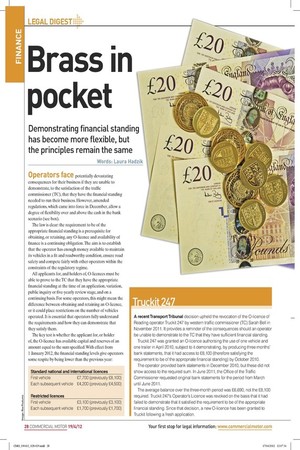Brass in pocket
Page 22

Page 23

If you've noticed an error in this article please click here to report it so we can fix it.
Demonstrating financial standing has become more flexible, but the principles remain the same
Words: Laura Hadzik Operators face potentially devastating consequences for their business if they are unable to demonstrate, to the satisfaction of the traffic commissioner (TC), that they have the financial standing needed to run their business. However, amended regulations, which came into force in December, allow a degree of flexibility over and above the cash in the bank scenario (see box).
The law is clear: the requirement to be of the appropriate financial standing is a prerequisite for obtaining, or retaining, any O-licence and availability of finance is a continuing obligation. The aim is to establish that the operator has enough money available to maintain its vehicles in a fit and roadworthy condition, ensure road safety and compete fairly with other operators within the constraints of the regulatory regime.
All applicants for, and holders of, O-licences must be able to prove to the TC that they have the appropriate financial standing at the time of an application, variation, public inquiry or five-yearly review stage, and on a continuing basis. For some operators, this might mean the difference between obtaining and retaining an O-licence, or it could place restrictions on the number of vehicles operated. It is essential that operators fully understand the requirements and how they can demonstrate that they satisfy them.
The key test is whether the applicant for, or holder of, the O-licence has available capital and reserves of an amount equal to the sum specified. With effect from 1 January 2012, the financial standing levels give operators some respite by being lower than the previous year: “Available” capital is defined as “capable of being used, at one’s disposal, within one’s reach, obtainable or easy to get” . The key questions to be answered are: “How much money can the operator find, how quickly and where from?” What may be accepted as evidence of financial standing? EC Regulation 1071/2009, which was implemented in the UK on 4 December 2011, initially allows three ways in which operators can satisfy the financial standing requirements: • certified annual accounts comprising balance sheet, profit and loss accounts, and notes on accounts; • certified opening balance for new operators – a properly accredited person can provide a statement of assets and liabilities before they started trading; • financial guarantee.
However, the UK has afforded greater flexibility to operators and the table provides examples of the evidence that might be taken into account for the purposes of demonstrating appropriate financial standing. ■ • Laura Hadzik is a solicitor specialising in road transport law at JMW Solicitors LLP, Manchester: laura.hadzik@jmw.co.uk; www.jmw.co.uk











































